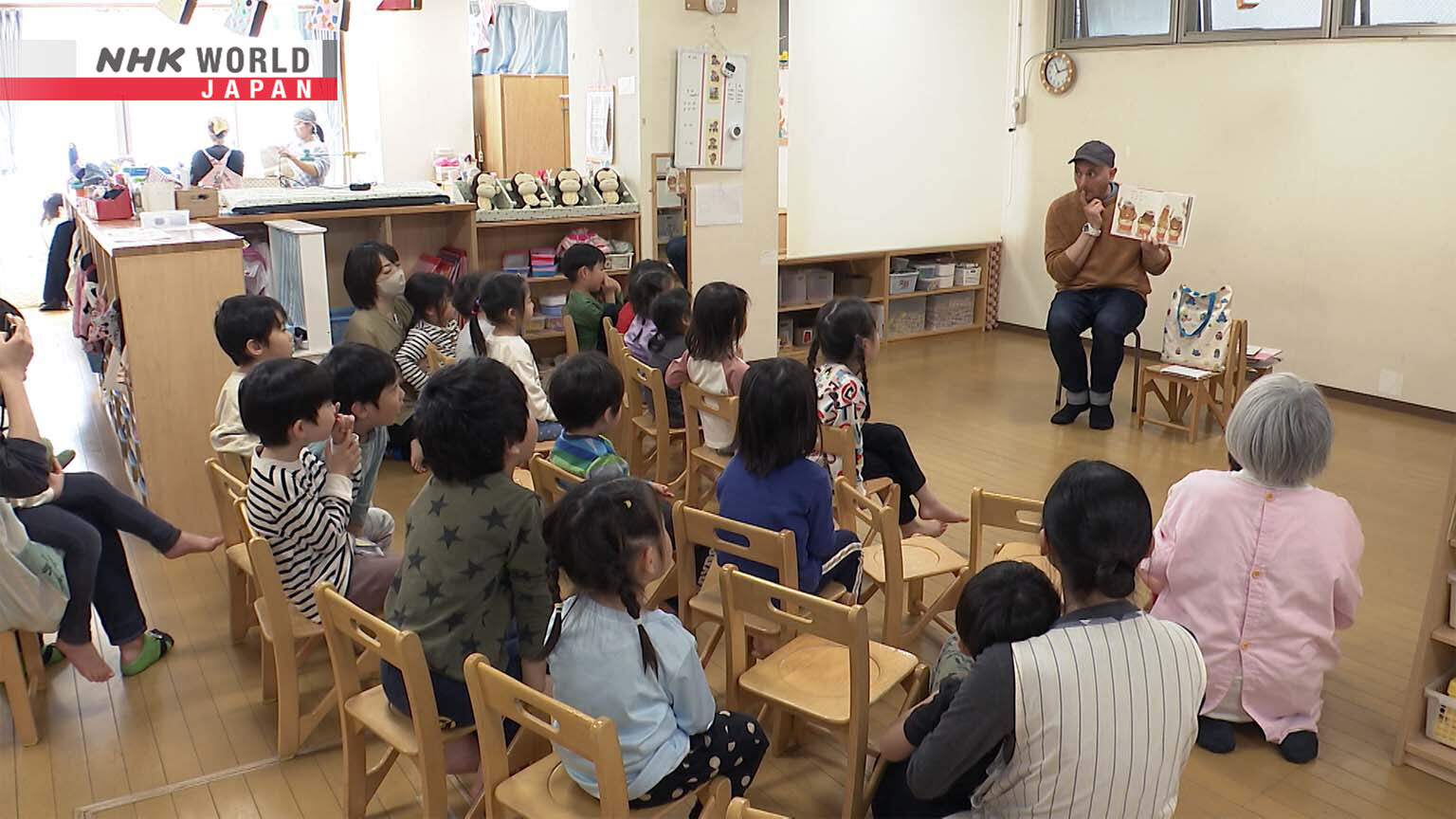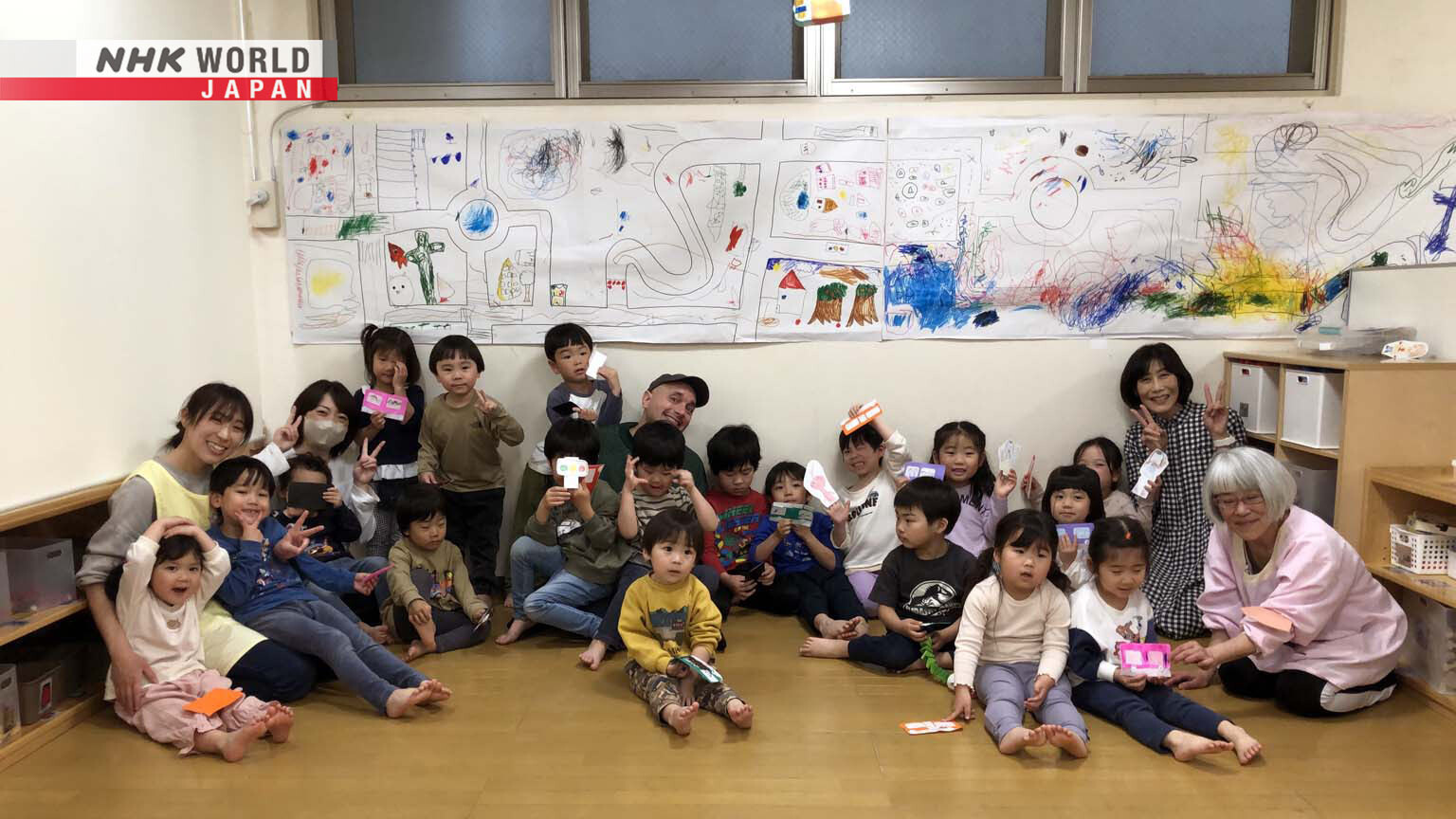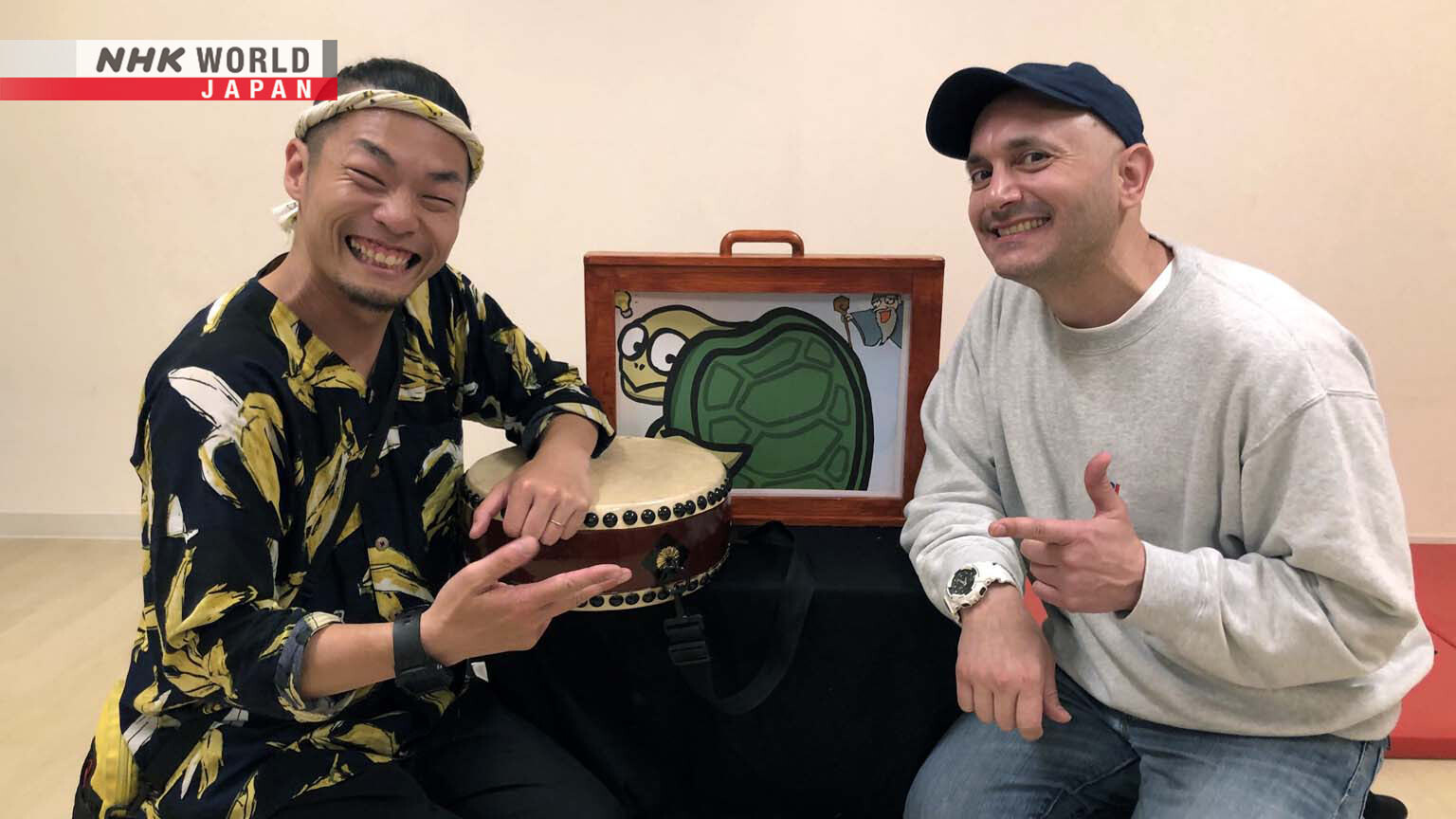Story Books Cross Barriers
On this episode, we meet American Jerry Martin, an author of children's books based in Saitama Prefecture, and Daniel Muivakitonyi from Kenya, a running instructor in Tokyo.




Transcript
Where We Call Home.
"Hira hira hira."
"Bubu bun bun."
"So many dandelions!"
Cheerfully reading one of his creations is children's book author Jerry Martin from the US.
He translates Japanese story books to English and writes his own in Japanese.
He does book readings at places like nursery schools.
One thing he particularly values is the sonority of words.
Some sounds are pleasing to the ear.
Fun sounds help convey a feeling even if you don't understand the words.
He now works on a picture-card storytelling performance that'll help Japanese kids learn English.
Let's follow Jerry in his work to help children discover the beauty of words and languages.
Saitama City is less than an hour train ride from central Tokyo.
This is where Jerry lives.
With a suitcase full of children's books he heads out to perform a storytelling session.
"Where are you off to today?"
I'm heading to a nursery school in Yokohama.
He arrives at a nursery school in Yokohama attended by some forty children.
Good morning!
Thanks for having me today!
Welcoming him is the head teacher.
They discuss how the activity will take place.
Can we remove the chairs?
Rather than having them sit quietly, I'd like the kids to be free to move.
- Some kids need a definite place.
- OK. That's fine.
Jerry adapts to the school's preferences.
- Hi!
- Welcome back!
Welcome back!
Back from a short walk around the neighborhood, the kids had been looking forward to meeting Jerry.
Today's audience: a total of twenty children between the ages of three and five.
Though Jerry has been doing this for ten years,
he always gets nervous when visiting a school for the first time.
Can you guess what's in my bag?
Books!
Who likes story books?
Wonderful!
His book An Acorn and a Drum is a rhythmical song that features the sound of drums.
"Don! Don! Doko! Don! Donguri! Don!"
"I beat the drum! Donguri Doko Don!"
It's a play on the sounds of "don," the Japanese onomatopoeia for a drum being hit,
and "donguri," the Japanese word for "acorn."
Animals join in with the acorns to play the drums.
"Don! Don! Doko! Don! Donguri! Don! Let me join in! Donguri Don!"
"Mr. Monkey, too! Doko Don! Doko Don Don!"
The words create a fun rhythm the kids seem to enjoy.
"All together! Donguri..."
"Don!!"
"Teku teku teku Bubu bun bun."
In his latest book, Mr. Bee's Spring Walk,
the titular bee invites other insects to go for a walk with him in a field of flowers.
"Hira hira hira. Bubu bun bun."
"Teku teku choko choko. Bun! Bun!"
"Teku teku bun bun!"
"Bun bun" is the buzzing of a bee, and "hira hira" represents a butterfly beating its wings.
The kids love it.
Some kids sang along.
One girl listened carefully.
Each child has his or her own way of enjoying it. It's great.
Thirty minutes can be long for little children.
But they laughed and had a great time.
This was a fun event for the kids.
As parents come to pick up their children, Jerry gives each one of them a copy of his book.
- Here you are.
- Thank you.
Four-year-old Shori will soon be moving with his parents.
He won't be coming to this nursery school for much longer.
Read it with Mommy at home. It'll feel different.
- Let's read it together.
- Nice!
See you tomorrow!
Jerry wants children to enjoy his books together with their families.
Shori moved to his new home.
Hi!
Come in!
Always bursting with energy, Shori almost never sits quietly to read at home.
But with Jerry's story book, it's different.
- What's written here?
- "Mr. Bee's Spring Walk!"
"Bun Bun Bun! Bubu Bun Bun! Bun Bun Bun! Bubu Bun Bun!"
"Come walk with me, Ladybug!"
"No, I'm too sleepy!"
Shori has just started to learn how to read.
He was quick to memorize and repeat the words in the book.
He likes the sounds in the book.
It seems to be easy and fun for kids to remember.
It makes him smile.
I think he wanted to do something together with us.
Reading together lets him do that.
Jerry's words help enrich the kids' sensibility and self-expression.
Some sounds are pleasing to the ear.
I use those sounds and weave them into stories.
If kids can feel those sounds...
they'll remain in their memories.
Jerry was born in California in 1980 to parents who immigrated from Portugal.
On the family farm, everyone spoke Portuguese, but outside of home, Jerry lived in English.
The environment he grew up in made him pay more attention to the different sonorities of languages.
As a kid, we'd speak Portuguese, English...
then in junior-high, I started learning Spanish.
I came to love the sounds of languages.
An avid bookworm since childhood,
Jerry first developed an interest in Japan thanks to a certain manga series.
Nausicaä of the Valley of the Wind.
He explains the story depicted a vast and deep world unlike anything he'd seen in American comics.
In American comics, villains come up...
and the heroes fight and beat them.
I thought we could only respond to violence with violence.
Nausicaä doesn't do so.
It left a strong impression that resonated with me.
Curious to learn more about Japanese culture, Jerry studied Japanese in university,
and, in 2004, he came to Japan to work as an English teacher.
Later, through story book reading sessions,
he fell in love with the beauty of the Japanese language,
and began to write his own children's books.
Jerry drops by his favorite local cafe.
- Hi!
- Jerry! Come in!
Long time no see!
- The usual?
- Yes. Espresso tonic.
He's particularly fascinated by the Japanese onomatopoeia that describe sounds and conditions.
Lately, he's really into expressions that refer to rain.
There are so many words for "rain."
Of course, we have rain in California, too.
But Japan has a rainy season.
In a country with more rainfall, there are more words for rain.
Pota pota - raindrops gently hitting the ground.
Zaa zaa - the sound of heavy showers.
Shito shito - quiet rainfall.
Soyo soyo - a refreshing spring breeze.
Pyuu pyuu - the rushing north wind.
Sawa sawa - wind that shakes the leaves.
Japanese abounds with onomatopoeia to express all kinds of things.
They're simple words, but they evoke the sounds so clearly.
There aren't that many in English.
It's an amazing aspect of Japanese.
And so, Jerry uses plenty of onomatopoeia in his books.
Bun bun - a buzzing bee.
Teku teku - footsteps.
Hira hira - A fluttering butterfly.
Choko choko - the ants follow along.
In this first book he translated,
Jerry says he had difficulty with the expression describing dandelion seeds floating in the wind.
There's a part where the seeds fly.
"Fu fu, fuwawawa wa! Howa howa, howawawa wa!"
Like that.
But there's no onomatopoeia for that in English.
What to do?
I did:
"Whoosh! Whoosh! Swirl, swirl, swoosh!"
Like that.
It's the sound of the wind more than the seeds' movement.
Jerry wants to further his understanding of the uniquely charming sounds
expressed in the Japanese language and use them in his future book projects.
He's currently preparing a picture-card play in English for a company
that runs some forty nursery schools and daycare centers.
In charge of the illustrations is Handa Takuya.
- Good morning.
- Good morning.
Thanks for having us.
Jerry is thinking of a story that would make learning English more fun and exciting for Japanese kids.
Takuya is a certified nursery school teacher and a picture-card play performer.
Known as "Gorilla sensei," he does storytelling sessions at nursery schools around Japan.
He and Jerry first met six years ago.
Sharing the same wish for families to enjoy children's books and picture-card plays at home,
they quickly hit it off.
The two are creating a play with protagonists based on themselves:
Gori the scatterbrain gorilla, and Jerry, a honey bee with magical powers.
They're writing a story that will include both Japanese and English.
Hey Jerry, It’s true. I wanted to read this book, but I can’t. Can you?
We should repeat words with the same sounds.
Even if the words are difficult, they can enjoy the sounds...
and it should make it easier to memorize new vocabulary.
Fukushima Kenyo, the company's president, is very hopeful for this project.
Jerry says he loves Japanese anime.
He loves Japanese culture. It makes us confident he understands how we feel.
We really felt a connection as we spoke.
English story books often feature rhymes.
And so, Jerry wants the picture-card play to also use a lot of rhyming.
"Blue, true, you, to..."
About 80% of English story books make use of rhymes.
I really love story books.
I feel using rhymes would make the play even more fun and exciting.
If we integrate the educational part in the story...
the kids will stay focused until the end.
The "Bean Counting Song" is a book Jerry translated.
He made use of rhymes to give the story a fun rhythmical feel.
The title had the word "song" in it. So, I wanted to add rhythm.
It's a song, so using rhymes would be a fun way to do it.
One little bean, down in the ground. Down, down, down, down in the ground.
It rhymes.
Two twin leaves, reaching for the sun. Up, up, up, ready for some fun.
I ended both phrases with the sound "un."
Through story books, Jerry wishes for children to discover the beautiful sonorities of Japanese and English.
Today, Jerry decided to perform the picture play in front of children
to test their response before they finalize the story.
Jerry: "Hey Gori, what's up? Why so blue?"
Gori: "I wanna read this book but I can't. Can you?"
In the story, Gori wants to read a picture book in English, but he doesn't know the alphabet.
And so, Jerry the Bee teaches him.
The children follow along with Gori to learn some basic English.
To make practicing the sound "a" as in "apple" more fun, Jerry added story elements before and after.
Jerry: "I'm gonna use my magic flute now."
"Piro piro piii!"
"Piro piro piii!"
Finally, Jerry the Bee's magic flute causes the apple to grow enormous.
Children have the talent to ignore the language barrier.
Kids are really full of potential.
So, we plant all kinds of seeds and see how they blossom.
Fun sounds help convey a feeling even if you don't understand the words.
If they discover how fascinating Japanese can be...
they'll love Japanese and want to preserve it.
With the rich sonorities of words and languages,
Jerry imparts his love of reading to children.
Story time continues!
Hi everyone!
I'm Daniel.
I'm an instructor for a running club.
I teach how to run marathons.
Chiyoda, Tokyo.
11 a.m.
lesson starts.
Sub-4 intervals.
Gather up!
Gather up. I'll do a headcount.
Daniel teaches beginners how to improve their speed and enjoyment.
Hi everyone!
Let's do our best today.
Many of the students enjoy running marathons in their free time.
This lesson is for those who wish to run a marathon in 4 hours.
Here's a key point to run 1km.
If your shoulders get stiff...
loosen them up like this. Do wide movements.
Front, front! Back, back!
To prevent injuries, he does warmups for better movement range.
Side, front, side...
Now, the left leg.
He makes sure to pay attention to each student and offers advice.
Today, we'll run five 1km stretches.
First, slow jogging.
Here we go!
He leads and sets the pace for a marathon in 4 hours or less.
Slow down here.
This is a 5min./km pace.
Can you run the last part?
Let's do it!
It's hot. But it's fun to run together.
Running a marathon is hard. But it's also fun.
It sure is!
Daniel enjoys running.
He makes running fun.
Daniel was born in Kenya, in the southern town of Machakos.
After high school, in 2012, he was recruited by a Japanese university.
The Hakone Ekiden is an intercollegiate relay marathon over 100 years old.
Daniel took part in this popular event and won the single-stage prize.
After university, his running skills earned him a place on a works team.
Wishing to teach the joy of running, he joined his current employer in 2017.
On the works team, we'd run until 8 a.m....
then slept until 3 p.m. We didn't do much.
I wanted to work for this company to become a coach.
It's fun to teach.
Seeing students beat their own record is so rewarding.
Early May. Hakone, Kanagawa Pref.
Daniel holds a special training session along the course of the Hakone Ekiden.
This is the toughest part.
The course is known for its many steep slopes.
This mountain path is rough.
It's the hardest.
Cheer up!
Just a bit more!
It's important to encourage them.
It helps them run through the course.
Well done!
Well done!
Coach Ishii is a fellow instructor.
Nice to meet you.
Kenyan runners grow up in an environment that develops their strength and speed.
Daniel ran instinctively. So, he had to learn how to teach.
I didn't know what A and B skip drills were.
But I observed Coach Ishii, and learned to mix in my own way.
He's great at making people laugh.
Now, do it correctly!
He's full of fun surprises for students. I wish I had that talent, too.
He's great at livening up a group.
My treasure is my family.
My wife sent me these photos.
Daniel's wife and their three children live in Kenya.
Daniel sends some money to support his family.
Looking at them powers me through the day.
Hi!
Hi!
- Did you sleep well?
- Yes.
- What'll you do after breakfast?
- I'll stay home.
I ask them how they are, what they ate, etc.
I miss them.
My kids are doing well. So, I can work hard.
My number one goal is to be a pro coach.
I want to coach athletes.